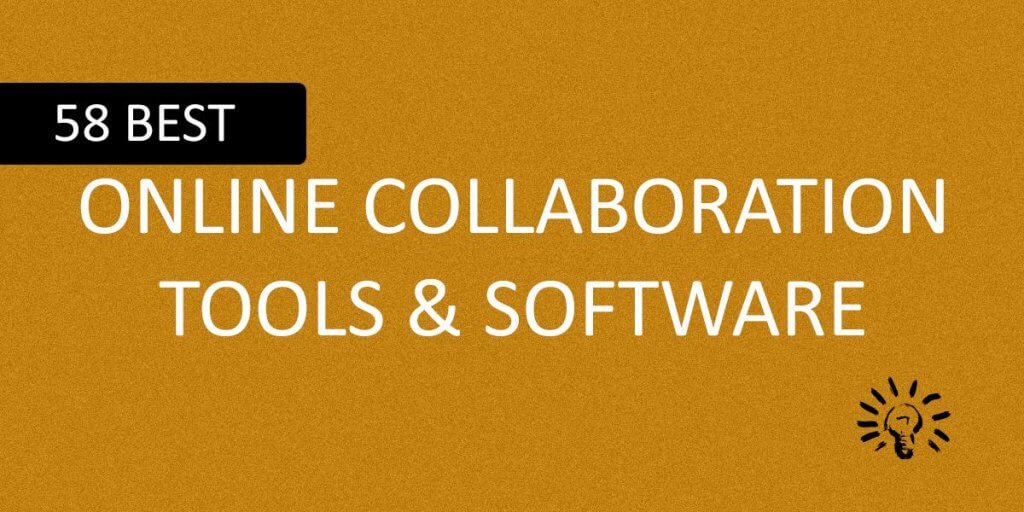What is Backblaze?
Backblaze is a backup service that offers personal and business plans. It is a straightforward system where you install a desktop client on your computer. The client then creates encrypted backups and sends them to secure Backblaze servers.
You can download the backups from the web interface, or you can order USB flash drive or USB Drives. The web interface and the desktop client are streamlined, making data backup a less strenuous task.
The system comes with a serious security flaw in the implementation of the private key encryption, which doesn’t make it a suitable option for highly sensitive data backup. Apart from that one flaw, it has a set of security features that are good enough for regular users.
It has a very competitive pricing structure, and it is ideal for backing up regular files like word documents, images, spreadsheets, etc. which do not have sensitive data on them. However, competitive pricing comes at a cost. The system lacks a few features that are usually desirable from any backup solution!
Backblaze Cloud Backup Review
Be honest and tell me, ‘when was the last time you backed up your computer data?’ Maybe you do it regularly with Google Drive or similar services. Even I do that!
But the storage space in Google Drive is minimal. You can upgrade, but that’s quite costly, with limitations on the storage space. The highest plan you can buy gives you 2 TB storage. Is that enough?
For some, yes! But for people like me who love to keep a stockpile of downloaded movies and TV shows, games (shhh… don’t tell anyone), and thousands and thousands of raw data files (like PSD, AI, website files, and more), 2 TB looks like mere peanuts!
Way out? Unlimited storage! What else could be the best fit for people like me?
Don’t you get scared when you think of unlimited storage? Wouldn’t that cost you a fortune?
Not really! In fact, you can get unlimited backup (truly unlimited) for just $60 a year! How does that sound?
You can happily back up every piece of data you have on your computer and sleep peacefully at night, thinking that even if the next morning, you wake up to a failed hard drive, you can recover all your data.
By now you must know which service I am talking about. Yes, it is Backblaze – a company that specializes in backing up data on the cloud.
But hey, don’t get into celebrations yet. There are a few catches here and there. After all, every glittering thing is not gold.
So, let us begin with the good side of Backblaze.
Creating the trial account
No, you don’t have to get a subscription right away. You can go for a free trial for 15 days. So, I will suggest that you opt for the free trial before committing with your hard-earned money.
I found the installation process to be fairly simple. I had to sign up with them. The signup process was a bit of a shock for me.
I use the usual password that I use almost everywhere to create these trial accounts. And trust me, it is not a password you can crack so easily.
I make sure that my passwords are at least 10 characters long with special characters, capital letters and lowercase letters, and numbers.
They told it’s not acceptable. So, I created a stronger password that they accepted. Only this time, the password was 24 characters long.
Never mind!
The password isn’t a big deal.
Once they accepted the password, they provided the installation file, which was downloaded automatically with on-screen instruction saying that I need to run it as administrator.
This is where I didn’t like it. Why run as an administrator? I know of services that don’t require such permissions.
I went ahead anyway.
The installation process was simple
I did what I was asked to do. I ran the file as an administrator. Windows gave a popup warning asking whether I should allow the application to make changes or not. I gave permission.
This is what it looked like:

Check out this video of the installation process:
The installation was simple. However, once the installation was complete, I wanted to make sure that Backblaze doesn’t take a backup of the ‘C’ drive. It is the drive where I installed my Windows (you know that already).
I don’t see a logical point in backing up the drive where the OS sits. I have the OS DVD available. I have a couple of USB drives converted into bootable flash drives.
So, there is no point in backing up the OS installation.
Backblaze did not allow me to do that. I was pretty disappointed with that. The disappointment didn’t last long when I started fiddling around with the settings panel.
Setting up the Backblaze
Once I had Backblaze up and running, all that I had to do was to ensure that the setting was according to my preferences.
So, I went to the settings control panel by clicking on the ‘Settings’ button on the application window. Check the image below:

The settings button is highlighted using a red color. The blue highlight shows that I am running the trial version and that the trial period will end in 15 days.
What To Backup
Clicking on the settings button pulls up a new popup window with all setting options that you can fine-tune.
This is what you will see:
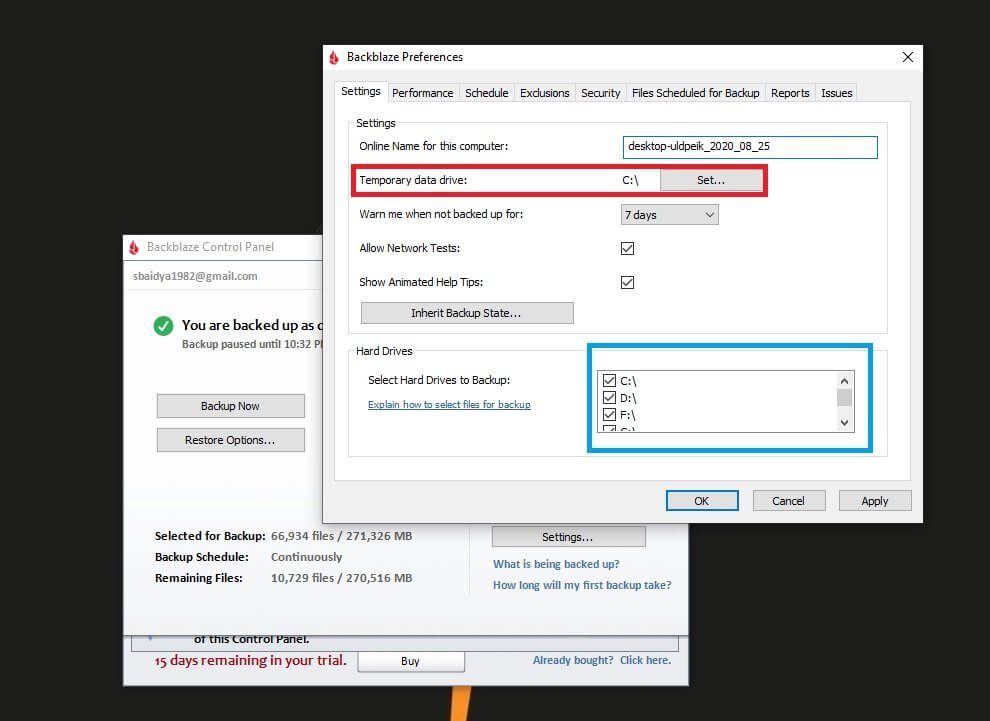
The section highlighted with red shows that Backblaze will set up a temporary data drive. This is where it does all the processing for the data that you want to backup.
If you don’t have enough storage space left in the default C drive, you can select any other drive. Don’t worry about the loss of space, because once Backblaze stops running, the temporary data will be gone.
What temporary data?
Well, Backblaze will encrypt your data before sending it to the cloud servers. It needs a place to do so. So, the drive you allocate will be the place where encryption will take place. The encryption process will create encrypted data, which is the temporary data because it will not stay on your computer anyway. It will be sent to Backblaze servers.
When you stop the backup process, Backblaze will release the space that is used for encrypting your data. So, you can select just about any drive you want.
The segment highlighted using blue color shows the list of drives that will be backed up. You can deselect the drives that you don’t want to back up.
I tried deselecting C drive, and this is what I saw:
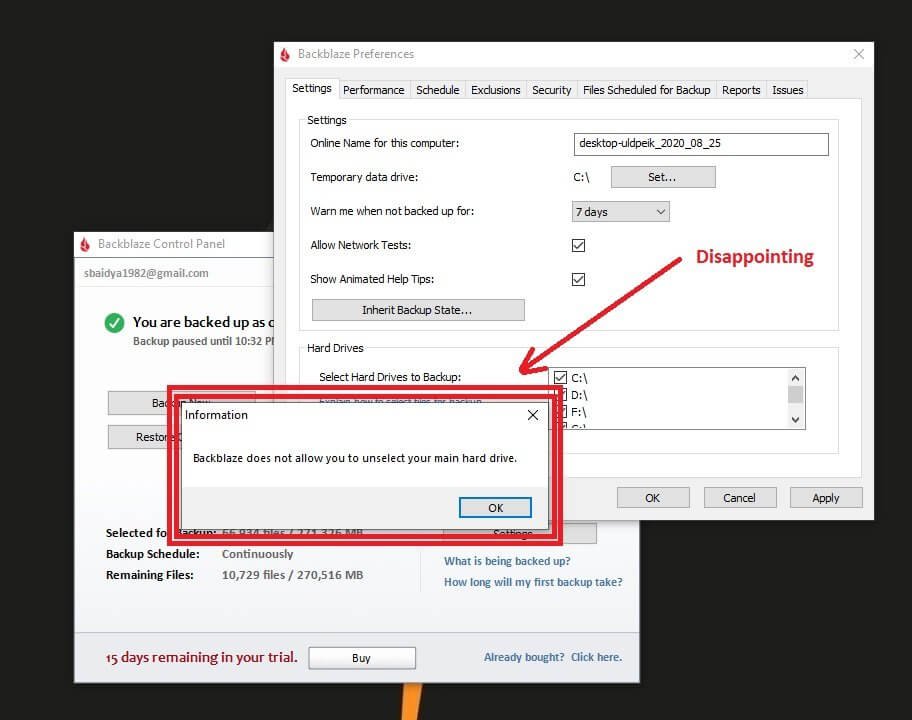
I was disappointed, but then I spotted the tab which says ‘Exclusions.’
What To Exclude From Backup
I clicked on the Exclusion tab to see this:
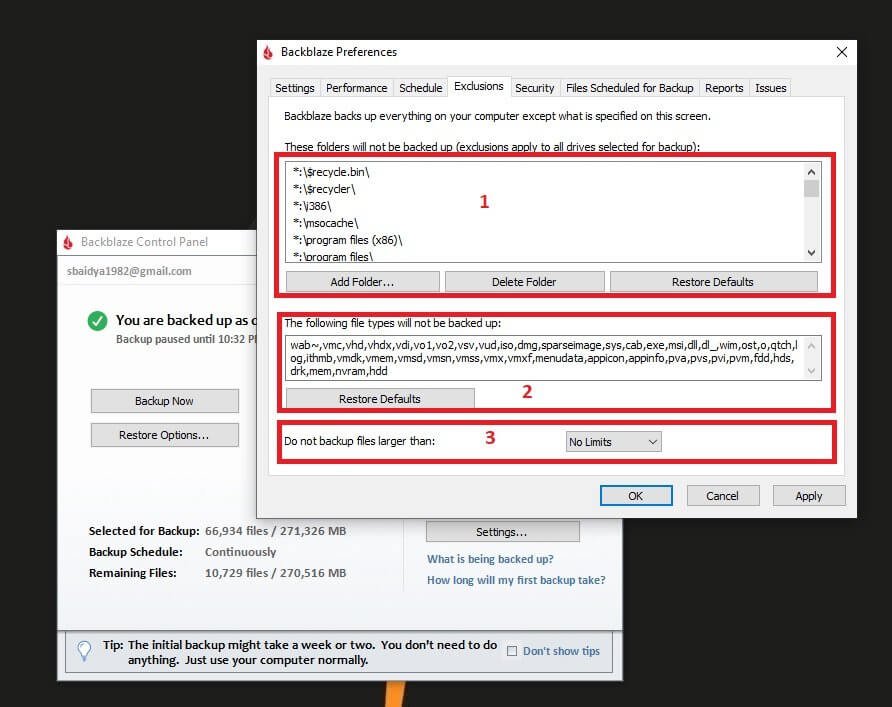
See the highlighted boxes numbered 1, 2, and 3.
Box 1 shows the list of folders that Backblaze will not backup by default. This includes my OS, program files, and more.
I also have the ability to add or remove folders as I deem fit. I really liked that flexibility.
Box 2 shows the type of files that the application will not backup. You can add other file types if you want. You can remove a few from the existing list.
Box 3 shows that you can exclude the backup of files that are larger than a specified size. I left it as no limits. You can go ahead and add a limit.
There was one problem that I noticed here.
If you want to exclude folders from backup, you can select only one folder at a time. So, if you want to exclude multiple folders, you have to do that one at a time, making the process fairly tedious.
Security Features of Backblaze
The next interesting tab for me was the ‘Security’ tab. I had no idea of what was hidden in that tab, and so I clicked on it to see this:
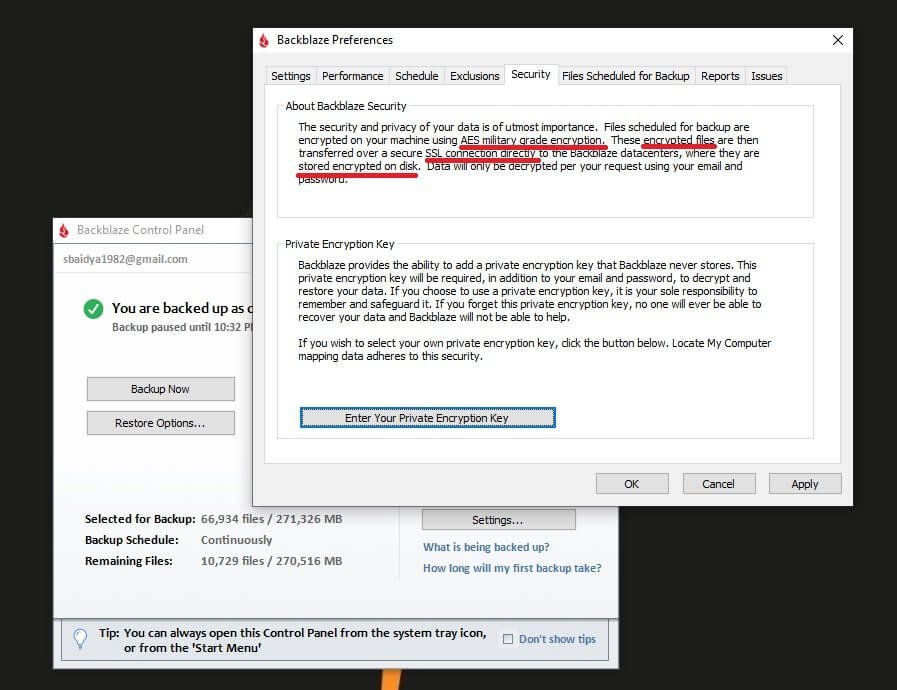
A few interesting words immediately caught my attention. Those words are:
- AES military-grade encryption.
- Encrypted files.
- SSL connection.
- Stored encrypted on disk.
I read the text to learn that they use AES encryption. It is definitely one of the most advanced encryption algorithms available today.
In case you don’t know, VPNs use this AES encryption, and they clearly state the length of the encryption key, which is 256-bit (in most cases).
A 256-bit AES encryption is the best option you will have. It is indeed military-grade encryption that even NSA openly advocates.
It is so strong that even the world’s fastest supercomputer will take billions of years to decrypt a single file encrypted using 256-bit AES encryption.
Now, Backblaze says that it uses AES encryption. It didn’t say anything about the encryption key length. So, I dug deeper into the Backblaze website to find out the length of the encryption key.
They use the 128-bit AES encryption to encrypt all data. See this:

Well, the 256-bit AES encryption is the top-tier encryption that is available today. Military forces use the 192-bit key or the 256-bit key. They don’t use the 128-bit key.
So no, Backblaze doesn’t truly use the military-grade encryption as it claims. You don’t have to get worried.
Even for a file encrypted with 128-bit AES encryption, a supercomputer will take millions of years (if not billions of years) to decrypt the file. It is not something someone will try.
Instead, a hacker will try to get hold of the key decryption key. Remember that in the case of AES encryption, the key which encrypts the data is also the key that decrypts the data. This is called symmetric cryptography.
This is the vulnerability that hackers try to exploit. They try to get hold of the AES encryption key. AES encryption works great if a single entity or organization controls both the server and the endpoints or the end devices.
Now, this is what Backblaze does:
- When you install the client, it will create a 2048-bit RSA public/private key pair.
- The public key will remain on your computer’s hard disk, and the Backblaze client installed on your computer will send the private key back to Backblaze servers over a secure HTTPS connection.
- Backblaze will then start encrypting data using AES encryption. For each encryption session, Backblaze will create a random symmetric AES key to encrypt the data.
- The 2048-bit RSA public key present on your computer will then encrypt the AES key.
- The data encrypted by the AES algorithm and the AES key encrypted by the 2048-bit RSA public key will then transmit over the Internet using HTTPS (SSL) and reach Backblaze servers or data centers.
- The 2048-bit RSA private key that was earlier sent to Backblaze servers will then decrypt the AES key first.
- The decrypted AES key will then decrypt the AES-encrypted data (if needed).
You may ask why the data is not encrypted using RSA-2048. The simple reason is that the 2048-bit encryption will slow down the data transfer dramatically.
Okay, it is too complex. I will stop right here! If I were to explain this to you, I have to write down a whole book on how encryption works. That’s never a viable option at the moment.
The bottom line here is that Backblaze uses very strong encryption technologies that make it nearly impossible for anyone to decrypt your data without any access to the RSA-2048 private key and the 256-bit AES key.
In case you want to create your private key to secure the encryption even further, you can do so. However, you need to remember that if you are creating a private key, you have to keep it safe. That is your responsibility.
If you lose the private key you make, no one on this planet can help you get back your data unless by a stroke of a chance someone guesses the key.
If you want to use your private key, click on the button which reads ‘Enter Your Private Encryption Key.’ A new popup window will open where you have to enter the private key twice. Check out this image:

I will repeat again – ‘Do not use this feature unless you are absolutely sure that you will never lose the key.’
When To Backup
Coming out of the security tab, I checked out the Schedule tab.
It essentially allows you to create a schedule for the backups to happen. You can let it run continuously, or you can ask the Backblaze client to do that once a day. Alternatively, you can do that manually.
For manual backups, you need to select the last option which says ‘Only when I click <Backup Now>.’
Here is what it looks like:
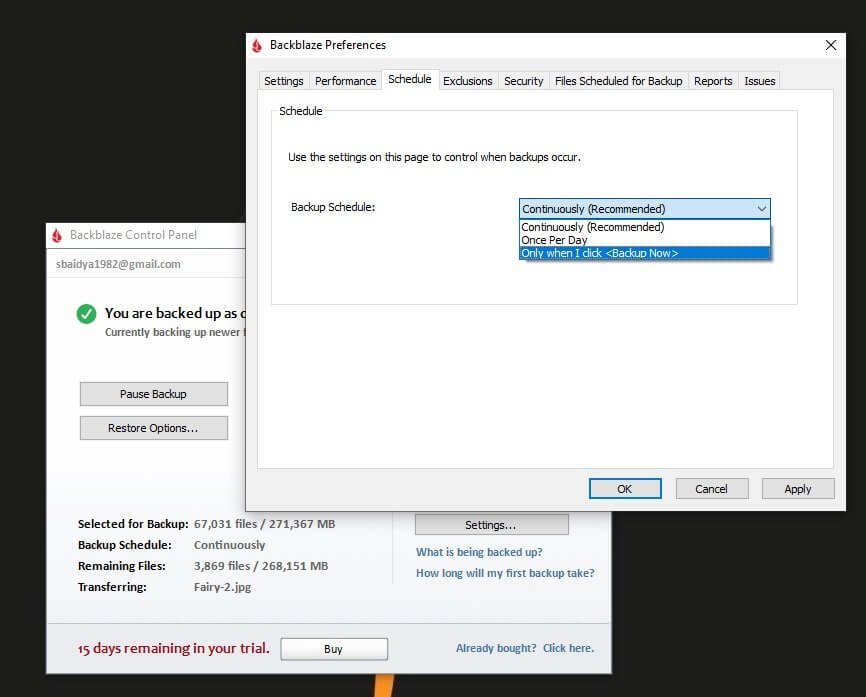
I will suggest that you use the recommended option (Continuously). That will ensure that you don’t have to worry about a sudden and unexpected hard drive failure that will stop the backup process midway.
Faster Backup or Faster Network
Moving to the Performance tab, I found this:

This is quite interesting. You can decide just how much of your network resources the Backblaze client uses to send the encrypted data to Backblaze servers.
The pre-configured settings are perfect because they ensure a nice balance between network speed and backup speed.
However, I will suggest that you use the Faster Backups option when you are not using the Internet (for instance, watching a movie saved on your hard disk) or when you think that your hard disk may fail any time.
The interface will also allow you to pause backups when you are connected to a certain Wi-Fi network.
This is particularly beneficial when you are using a public Wi-Fi network.
Inherit Backup State
Getting back to the Settings tab, you will find something interesting called “Inherit Backup State.”
What on Earth is that?
It simply means that if you have recently changed your operating system, or you moved the Backblaze client to a different computer (that is uninstalled it from your current computer and installed it on another computer), Backblaze will start backing up files from where you left on the previous OS or the previous computer.
This feature is quite interesting.
Imagine a situation where you reinstalled your operating system while keeping all the files intact.
If you start Backblaze on this freshly-installed OS, it will start right from the beginning. Why would you want to back up the files that were already backed up? Will it not eat up your network bandwidth?
So, resuming from where you left makes much more sense.
However, if you want to use the feature, you have to sign in using your Backblaze credentials.
This is what it will look like:
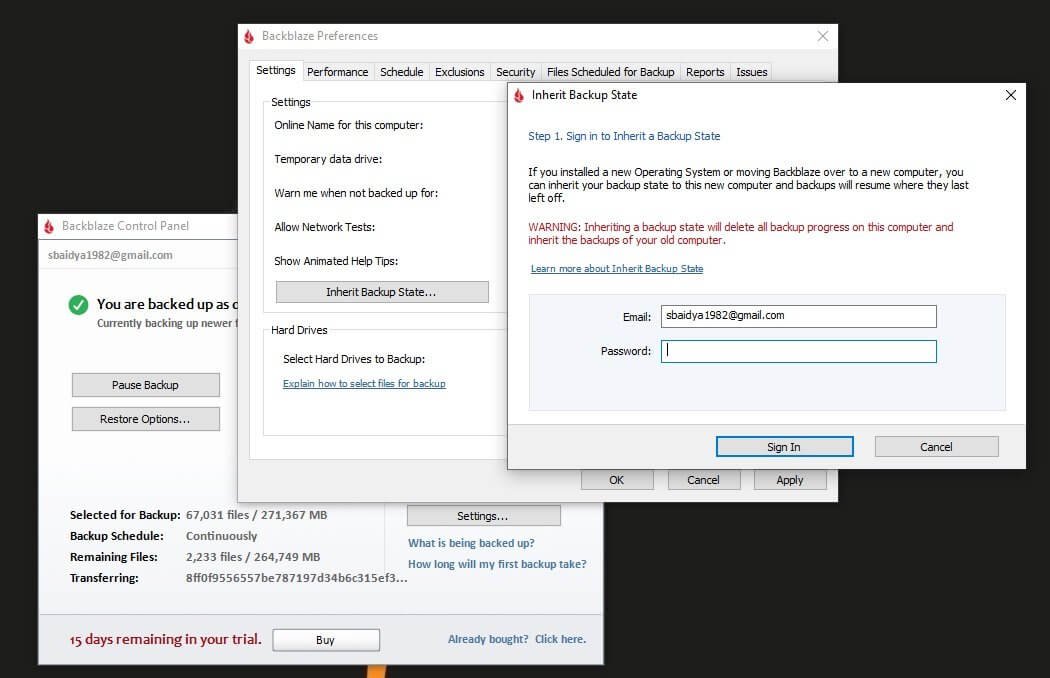
Restore Backup
What if you want to restore the backup created by the client on Backblaze servers?
The primary client window has the Restore options for you. Click on it to see a new popup window. You will see this:
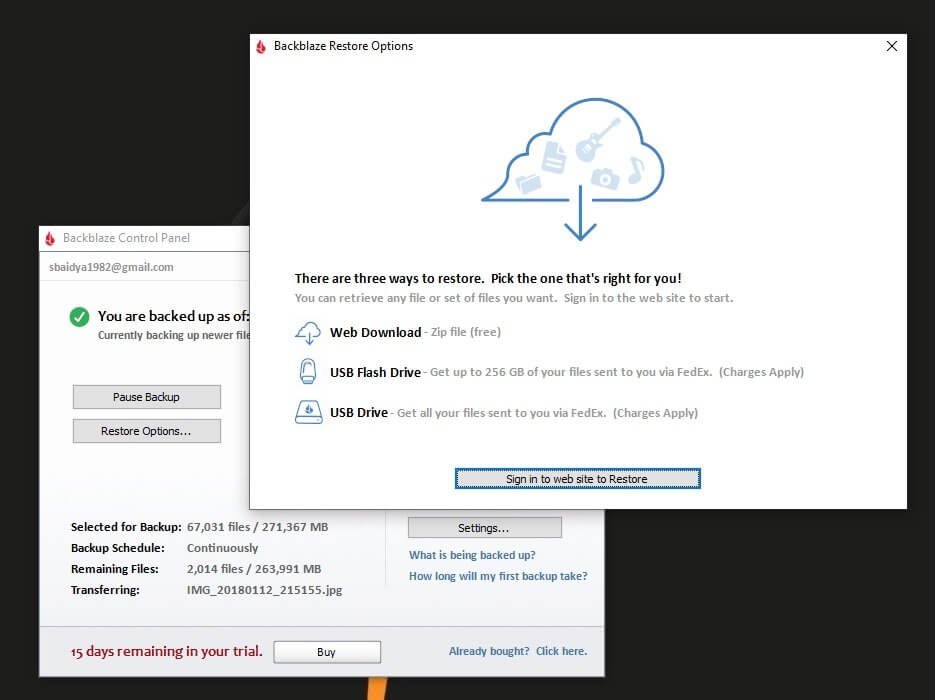
There are three ways you will get your backups. You can download a zip file, for which you need to sign in to the web portal of Backblaze.
Alternatively, you can order a physical USB flash drive or a physical USD drive. Backblaze will ship them to you via FedEx. However, there will be a shipment charge.
If you are ordering a flash drive, the maximum data you can get back is 256 GB. If you have backed up more data or all your data, you will need to order the USB drive.
That’s all!
Wasn’t the client simple enough? I found it to be straightforward without too many options that can lead to confusion.
But what does the Backblaze web interface offer?
Let’s find out…
The Web Interface of Backblaze
Signing into the website of Backblaze, you will see that it is just as clean and simple as the desktop client. This is how it looks like:
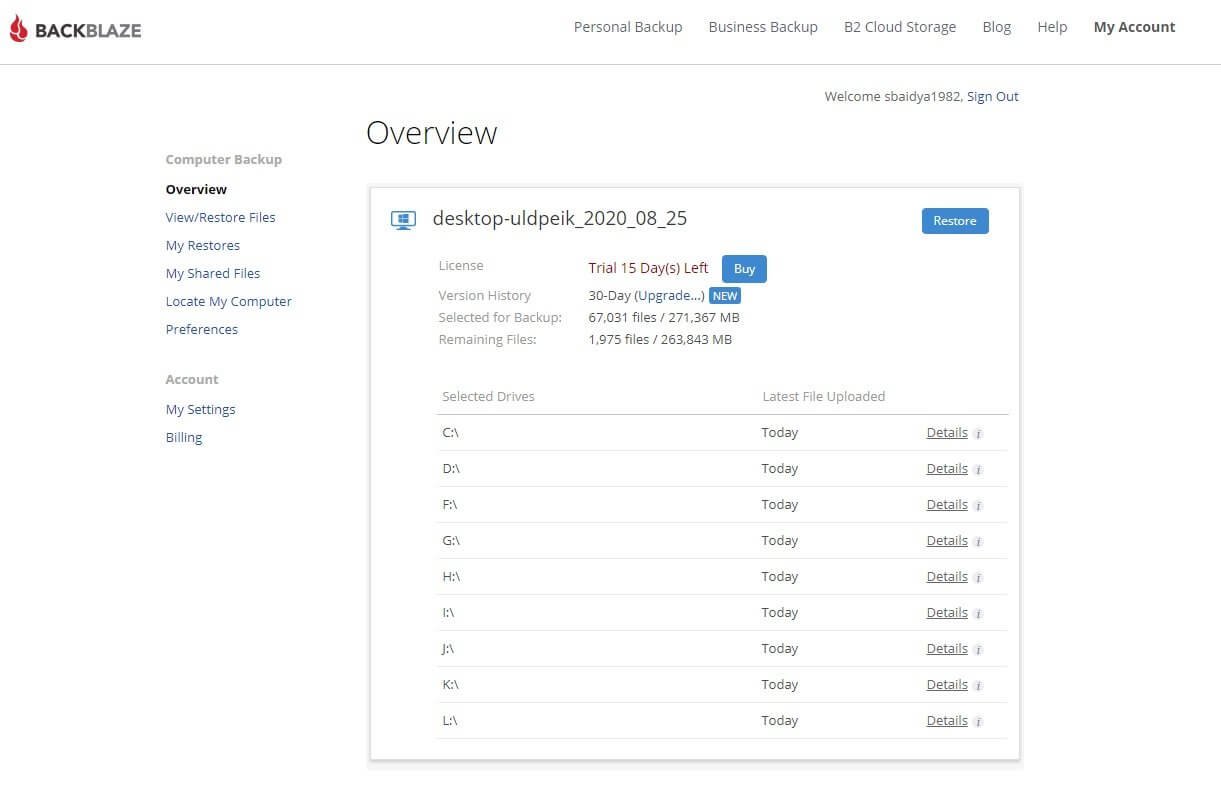
Overview and View/Restore Files Tabs
The Overview tab on the left will show the files that the client backed up recently. You have a nice Restore button on the top right corner. Click on it will show this:
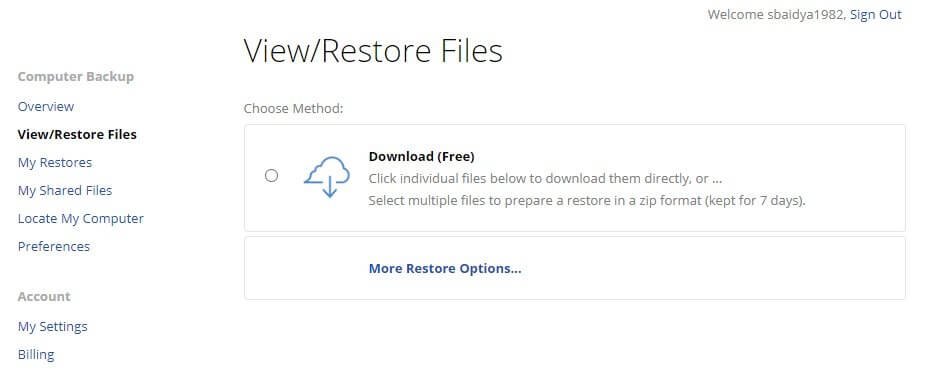
So, you just move on to the View/Restore Files tab. That’s it! You can download the backup files from here as a zip file.
You have to create the zip file by selecting the files you want to restore. This zip file will stay for 7 days only.
Clicking on the Download (Free) option will scroll up the page automatically to show this:
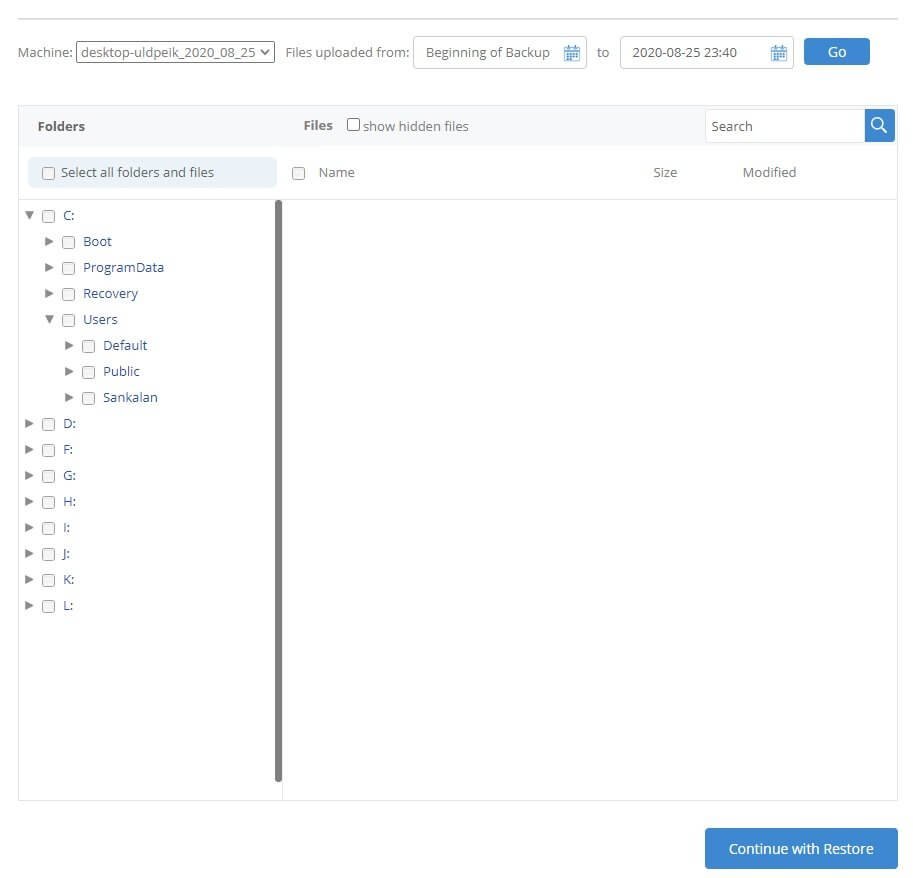
Once you select all the files and/or folders that you want to restore, click on the ‘Continue with Restore’ button you see at the bottom. Once you do that, this is what you will see:
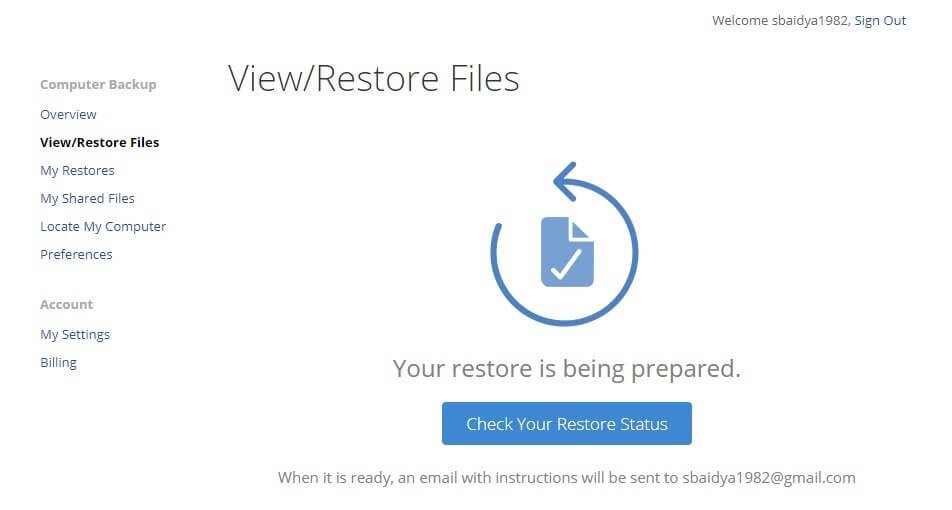
Once the restoration file is created, you will receive an email.
This is what you see in the email body:
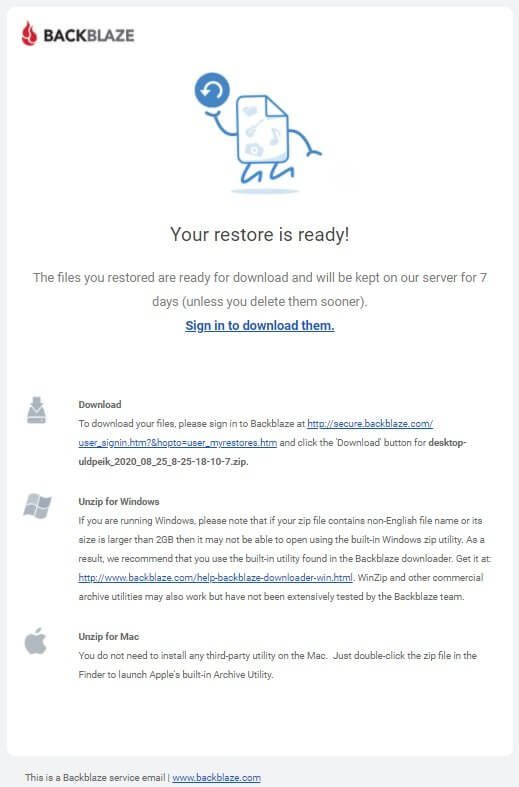
My Restores Tab
Moving on to the My Restores tab on the web interface, you will see this:

Here you will see Backblaze advertising on of their products – Backblaze Downloader. You can install it on your computer, and according to them, it allows you to download your backups faster.
You will also see the zip files available for download. You can download the zipped file by clicking on the download button.
Even the email body said that you will find the zip file in this tab!
My Shared Files Tab
There is an interesting feature available that will allow you to share your backed up files with anyone you want.
However, for this, you will need a B2 account, which is an upgraded account with cloud storage that Backblaze offers.
If you want to share any file, you can do that directly from the View/Restore Files tab. You can drill down on a file that you want to share from the left navigation pane. It looks like this:
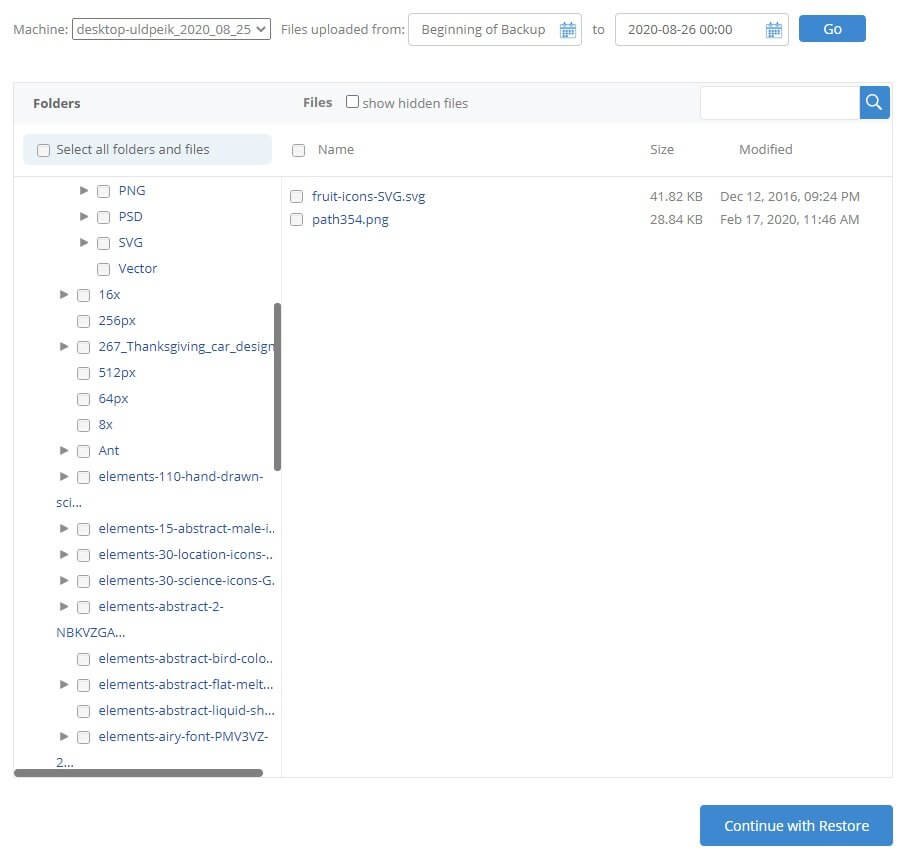
Click on any file on the right page, and you will see this:

You can directly download the file on your hard drive, or you can share a link with anyone. The person with the link can download the file.
If you are sharing links with someone, the My Shared Files tab will show the list of all files that you have shared.
Locate My Computer Tab
This was a surprise for me. I never expected this. Backblaze gives you the option of locating your computer if you have lost it somewhere. Typically it is for laptop users (unless someone breaks into your house and steals your desktop).
This is how it looks like:
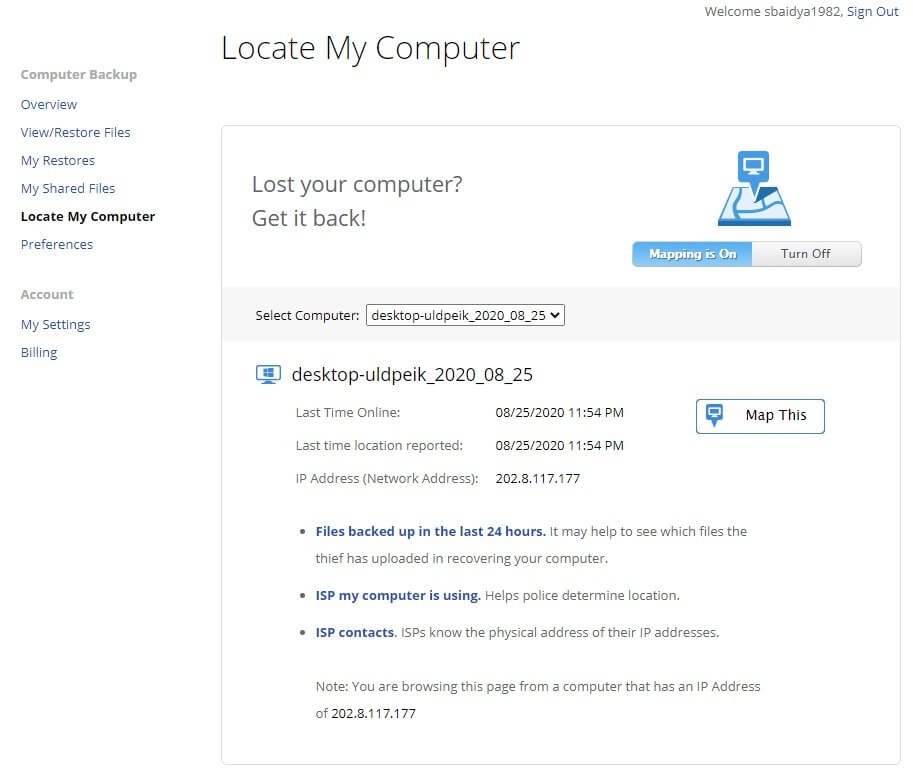
The ‘Map This’ button that you see on the image will not work for me because I don’t use a laptop, and I don’t carry around my desktop.
If you have a laptop, the Map This feature will work because it will create a map of all the locations your laptop has been to.
Preferences Tab
The Preference tab is the place where you can delete your backup files, unsubscribe from marketing emails, see the plan you have purchased, and the frequency of backup summaries.
There is nothing to explain here.
This is how it looks like:
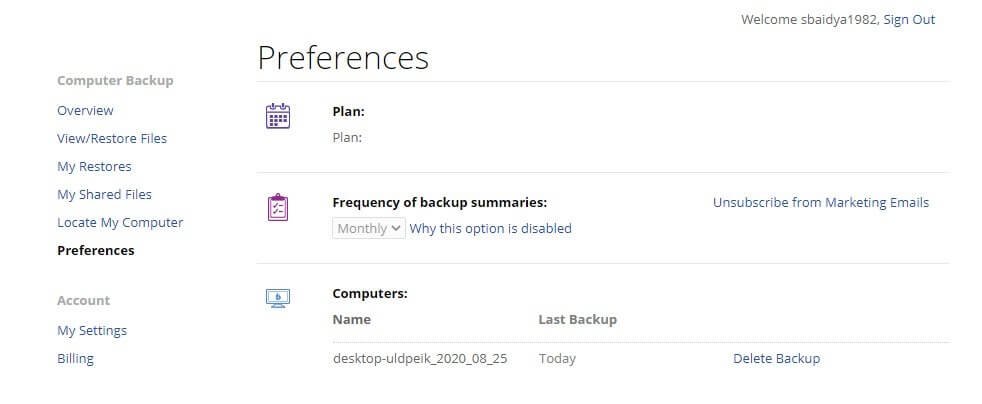
You will notice that the ‘Frequency of backup summaries’ option is disabled here. That happens when you use a free trial. It becomes active only when you purchase a plan.
My Setting and Billing Tabs
This is where you can take control of your Backblaze account. You can change your details, add a phone number, use two-factor authentication for account login, change your password, etc.
Nothing big here! Just go through it, and you can change or add whatever you want. This is how the tab looks like:

Do I even need to explain the Billing tab? Fine! I will!
The Billing tab gives you a summary of all your past and present payments. There is nothing more to say! This is how it looks like:
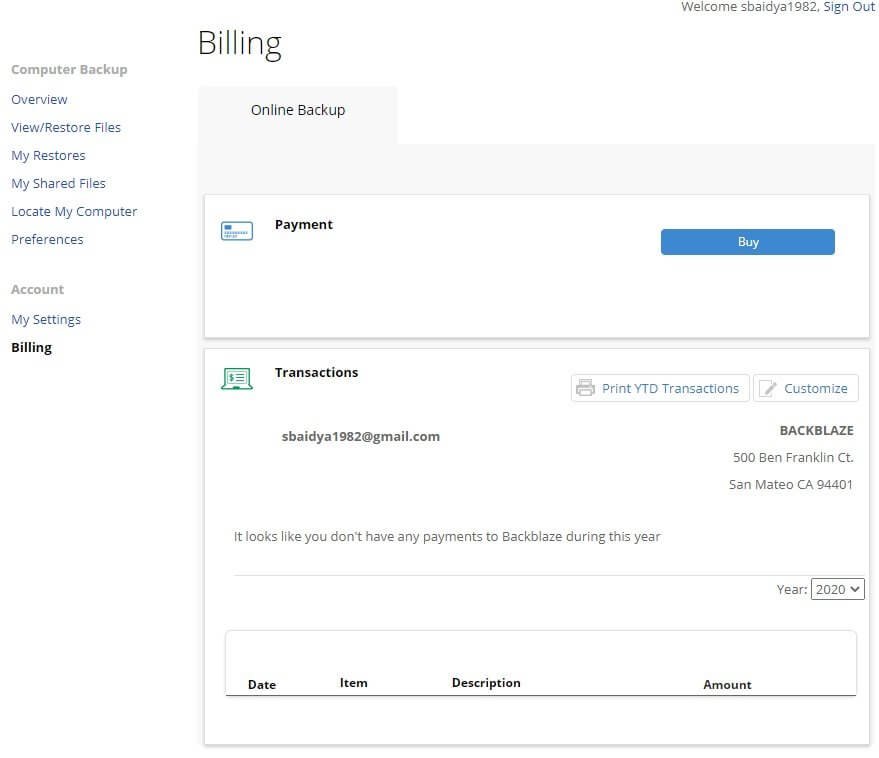
So, the web interface is very intuitive and straightforward. The minimal design stays in tune with the desktop client’s basic options.
Advantages of Backblaze
Backblaze is a simple and effective backup service. It does what it says – backs up your files from your computer to Backblaze servers. If you were expecting more, you would be disappointed.
Here is a list of things that I think are the strengths of Backblaze:
- It gives unlimited backup. There is no restriction on the storage space.
- The overall experience is streamlined. The desktop client and web interface are clean and easy to understand.
- It comes with the ability to share files.
- The security features are decent (not top-of-the-line).
- Backblaze is GDPR compliant.
- It allows continuous backup. You can go for incremental backup as well.
- You can backup external drives attached to your computer.
- If you delete a file, Backblaze will retain the file for 30 days.
- It allows speed throttling to give you control over your network resources.
Disadvantages of Backblaze
There are some serious disadvantages to Backblaze. Read them carefully:
- One license will allow you to backup only one device.
- They are not HIPAA compliant. This means you should never backup sensitive patient data with them (especially applies to doctors).
- They do not have a mobile device backup option. Considering that today’s mobile devices are powerful and store a lot of important data, the absence of mobile device backup is a serious flaw.
- They have NAS, Veeam, and Server backup options, but only for the business backup plan. [This should not be a big problem, because both the business and personal backup plans cost the same. If you are an individual playing around with these things, go ahead and by the business backup plan. It will not cost you anything extra.]
- They don’t have telephone support and 24/7 support. You can contact them only using email or chat, and that too, during specified hours.
Big Security Flaw – The Implementation of Private Key
If you are setting up a private key, the only way you can get your backup files is through the web download, where you need to provide your private key to get access to your backup. This is a security flaw.
Backblaze claims that it doesn’t store the private key, the real threat comes with what is known as “Man in the Middle Attack.”
You cannot rule out the possibility that a hacker compromised your network or the servers of Backblaze. In such a situation, the hacker can be sitting right between (in the middle, and hence the name, Man in the Middle) your computer and Backblaze server, and the moment you enter the private key, the hacker gets access to all your data.
Pricing Policy
Backblaze has a simple pricing policy. There are three options to select from. They are:
- Monthly payment – You need to pay $6 per month.
- Yearly payment – You need to pay at the rate of $5 per month. You will be billed once every year. You need to pay $60 at once.
- Bi-yearly payment – You need to pay at the rate of $4.58 per month. You will be billed once every two years. You need to pay $110.00 at once.
Conclusion – Do I Recommend Backblaze?
If you are thinking of backing up highly confidential data, I will never recommend Backblaze. The significant security flaw in the implementation of the private key is something you should be wary of.
However, if your intention is to backup your regular word documents, spreadsheets, movies, music, images (don’t put extremely personal images on Backblaze servers), using Backblaze is perfectly fine.
It has a simple pricing structure and a straightforward backup system that works perfectly fine for most of the users.
Do I use Backblaze?
No, I don’t! I keep separate high-capacity external SSD drives with biometric (fingerprint) locks, and I keep them off my network. That’s my policy. It costs a bit more than online solutions, but that’s the tradeoff I am ready to make. If you cannot afford such external drives, going for Backblaze or similar services will make sense.

